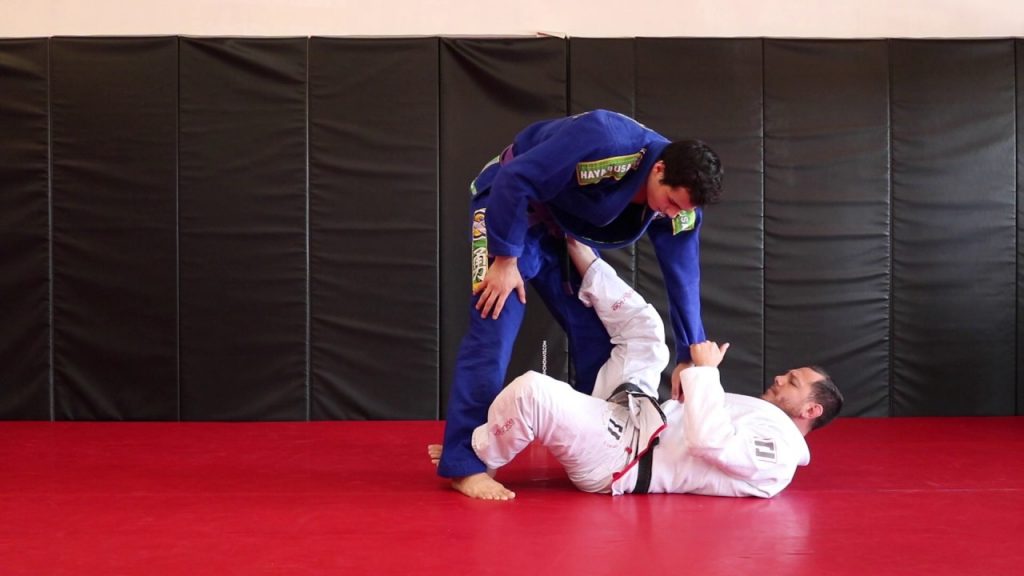
Despite all my attempts at organizing intro classes and special introductory groups for the newest member of my gym, people are still completely and utterly lost. It is not about the first few days or weeks even. You can find a way to make those highly enjoyable and interesting to new folks, plus teach them a thing or two in the process. The hard part comes after the first month when people try and figure out what to do in every situation. In order to make things easier for the Jiu-Jitsu beginner that is heading for a few months of anguish and suffering, here are 7 BJJ beginner moves that will help make sense of things as you go along.
BJJ beginner moves are nothing special compared to all other moves in Jiu-Jitsu. In fact, those happen to also be the moves that work perfectly at the highest levels of BJJ as well, after about a decade of practice. That said, certain moves are simple for people who are new to understand and are going to work for them even against higher belts. These were the only two standards I used when trying to figure out what the 7 key BJJ beginner moves are. Furthermore, these moves pretty much focus on all the positions you’ll find yourself in constantly during grappling, so they might just yield interesting options for non-beginners as well.
Deciding What To Focus On
This is the hard part. BJJ beginners have no idea what to focus on, and that’s precisely why there’s a coach around. I’ve said many times before that nobody can teach you Brazilian Jiu-Jitsu but yourself. I still believe that to be true. However, I also believe that guidance is massively helpful when you’re trying to figure out how the Gentle Art will work for you best.
Given that BJJ is highly versatile and is growing every day, it can be really hard for new students to choose what they need to focus on. After blue belt, people usually start “specializing” in area after area, speeding months, and sometimes, years figuring things out. A white belt beginner doesn’t have that option, though – they need to learn how to swim before they drown. Only later can they mess around with different swimming styles or try and dive deeper. This is exactly where the coach comes in.
As a coach, you need to be able to tell your students how swimming is done, but let them figure out their best approach y themselves. That said, you’ll still need to give them the basics of staying afloat, using limbs to propel themselves through the water, and the rhythm of breathing that will keep them going. As students, you need to learn to listen to your coach, particularly during this period of your BJJ journey which is definitely the hardest. Once you have everything you need to stay afloat, you can go about finding your own swimming style. If you truly want to become a shark, there are certain BJJ beginner moves that you need to imprint in your DNA as soon as possible. Here are the 7 most important ones.
BJJ Beginner Moves: The Top Picks
There will be alto of time to explore spinning, flying, and inverting things as you progress through Jiu-Jitsu. In the beginning, you’ll need a set of tools to help you deal with the most common things people will throw at you. Given that you’ll need to roll not just with fellow white belts, but also every other belt in the gym, you can’t just rely on athleticism or instinct. Instead, you need to master the following 7 BJJ beginner moves to be able to deal with the sharks trying to eat you alive while you’re swimming.
To that extent, the BJJ beginner moves you need are a submission hold, a guard of safety, a common guard pass, a sweep, a takedown, an escape, and an overall concept to give you meaning. Since different things work differently for different people, we’ve made a list of the moves that have been proven to work for everyone at every belt level, and are not hard to understand and learn.
The Submission – Rear Naked Choke

The Pass – Half Guard Smash Pass

The most basic Half Guard pass you can use is the smash pass. All you need to remember is to hug the head, get an underhook, and place the bottom person with their back on the ground. Keeping them there is what will allow you to pass. Use the free leg to hook the nearest thigh and shake your trapped leg free for a pass to side control, or directly into the mount.
The Guard – Closed Guard

The thing to remember about the guard in BJJ in general, especially as a beginner is that it serves one main purpose – keeping an opponent from getting past your legs. All the attack stuff is what comes after, and there’ll be plenty of time to mess around with it later on.
The Sweep – Tripod Sweep

The tripod sweep is easy – hold one arm, hold the same side leg, and have one of your legs on the opponent’s hip. The moment you feel like it, use the other leg to trip their free leg, preferably from behind the heel. As far as BJJ beginner moves go, this is the one sweep that will make all the difference every time someone forces open your closed guard.
The Takedown – Ankle Pick

The ankle pick takedown setup is beyond simple. Get a grip behind the head, or at the collar with one arm, and control the opposite side arm with the other. The goal is to force the opponent to turn towards the side of the arm you’re controlling, while you pull them downwards. When you achieve that, go to one knee, let go of the arm, and catch the ankle of the nearest leg. It can be either leg, really. Get up and pull for one of the easiest takedowns you’ll ever get.
The Escape – Frame From Bottom Mount
Mount is the one spot you’ll constantly end up as a beginner, and you will feel absolutely claustrophobic in there. That’s why I consider escaping this position to be the most important and first escape any new student should learn.

The execution is once again really simple. Use your arms to frame the opponent’s hips, turn to one side and pull the bottom leg up, aiming to touch your elbow with your knee. Escaping your hips while doing this will get you out quicker, but you could pull a frame escapee out without shrimping too. BJJ beginner moves don’t get simpler than this, really.
The Concept – Be On Top
Finally an overall concept in Jiu-Jitsu that’s a real game-changer for anyone, not just new students. However, teaching people this has proven to be much more effective than teaching it to more experienced students. The reason is that newbie are open to learning and don’t have bad habits formed through training.

Closing Thoughts
BJJ beginner moves come in all shapes and sizes. Having a simple thing to do from every common position will give you more than a fighting chance. In fact, it will start to open up doors and opportunities for your own creativity to come through the moment you start feeling a bit more comfortable on the mats. Until then, you’ll have “safe spots” to fall back to, and go-to moves that will cause trouble even for the black belts in your gym. Happy rolling!


![Darce Choke Encyclopedia – Origins, Mechanics and Variations [2025] BJJ, choke, Brabo, BJJ Darce Choke, D'arce Choke, Darce BJJ Choke](https://bjj-world.com/wp-content/uploads/2017/11/JungPoirierLeeYahoo-218x150.jpg)









![Get Off My Legs Gringo Craig Jones DVD Review [2025] Get Off My Legs Gringo Craig Jones DVD Review](https://bjj-world.com/wp-content/uploads/2025/03/get-off-my-legs-gringo-craig-jones-dvd-review-218x150.png)

![Leg Lock Entries Helena Crevar DVD Review [2025] Leg Lock Entries Helena Crevar DVD Review](https://bjj-world.com/wp-content/uploads/2025/03/leg-lock-entries-helena-crevar-dvd-review-218x150.png)
![Special K Guard Neil Melanson DVD Review [2025] Special K Guard Neil Melanson DVD Review](https://bjj-world.com/wp-content/uploads/2025/03/special-k-guard-neil-melanson-dvd-review-218x150.png)
![Arm Bar It All Shawn Melanson DVD Review [2025] Arm Bar It All Shawn Melanson DVD Review](https://bjj-world.com/wp-content/uploads/2025/03/arm-bar-it-all-shawn-melanson-dvd-review-218x150.png)


![Full Guard Formula James Booth DVD Review [2025] Full Guard Formula James Booth DVD Review](https://bjj-world.com/wp-content/uploads/2025/02/full-guard-formula-james-booth-dvd-review-100x70.png)
![Master The Move Anaconda Strangle John Danaher DVD Review [2025] Master The Move Anaconda Strangle John Danaher DVD Review](https://bjj-world.com/wp-content/uploads/2025/02/anaconda-strangle-john-danaher-dvd-review-100x70.png)



![Bricks Kesa Gatame System Jeremy Brick DVD Review [2025] Bricks Kesa Gatame System Jeremy Brick DVD Review](https://bjj-world.com/wp-content/uploads/2025/02/bricks-kesa-gatame-system-jeremy-brick-dvd-review-100x70.png)

![Slip N Slide Into Victory Julián Espinosa DVD Review [2025] Slip N Slide Into Victory Julián Espinosa DVD Review](https://bjj-world.com/wp-content/uploads/2025/01/slip-n-slide-into-victory-julian-espinosa-dvd-review-100x70.png)


![Woj Lock the World Chris Wojcik Ankle Locks DVD Review [2024] Woj Lock the World Chris Wojcik Ankle Locks DVD Review](https://bjj-world.com/wp-content/uploads/2024/12/woj-lock-the-world-chris-wojcik-dvd-review-100x70.png)





![BJJ Foundations Mikey Musumeci DVD Bundle Review [2024] BJJ Foundations Mikey Musumeci DVD Bundle Review](https://bjj-world.com/wp-content/uploads/2024/09/bjj-foundations-mikey-musumeci-dvd-bundle-review-100x70.png)
![Crush The Guard Vagner Rocha DVD Review [2024] Crush The Guard Vagner Rocha DVD Review](https://bjj-world.com/wp-content/uploads/2024/10/crush-the-guard-vagner-rocha-dvd-review-100x70.png)
![Shotgun Aoki Locks Mateusz Szczecinski DVD Review [2025] Shotgun Aoki Locks Mateusz Szczecinski DVD Review](https://bjj-world.com/wp-content/uploads/2025/03/shotgun-aoki-locks-mateusz-szczecinski-dvd-review-100x70.png)
![Creating Back Exposure Luke Griffith DVD Review [2025] Creating Back Exposure Luke Griffith DVD Review](https://bjj-world.com/wp-content/uploads/2025/01/creating-back-exposure-luke-griffith-dvd-review-100x70.png)
![Dubious De La Riva Dominique Bell DVD Review [2024] Dubious De La Riva Dominique Bell DVD Review](https://bjj-world.com/wp-content/uploads/2024/10/dubious-de-la-riva-dominique-bell-dvd-review-100x70.png)
![Special K Guard Neil Melanson DVD Review [2025] Special K Guard Neil Melanson DVD Review](https://bjj-world.com/wp-content/uploads/2025/03/special-k-guard-neil-melanson-dvd-review-100x70.png)

![Dynamic Headquarters Passing Jason Rau DVD Review [2024] Dynamic Headquarters Passing Jason Rau DVD Review](https://bjj-world.com/wp-content/uploads/2024/10/dynamic-headquarters-passing-jason-rau-dvd-review-100x70.png)


![Just Pass Jay Rodriguez DVD Review [2024] Just Pass Jay Rodriguez DVD Review](https://bjj-world.com/wp-content/uploads/2024/11/just-pass-jay-rodriguez-dvd-review-100x70.png)
![Back Control and Submission Felipe Pena DVD Reveiw [2025] Back Control and Submission Felipe Pena DVD Reveiw](https://bjj-world.com/wp-content/uploads/2025/01/back-control-and-submission-felipe-pena-dvd-reveiw-100x70.png)
![The Buchecha Gi Takedown System DVD Review [2025] The Buchecha Gi Takedown System DVD Review](https://bjj-world.com/wp-content/uploads/2025/01/buchecha-gi-takedown-system-dvd-review-100x70.png)